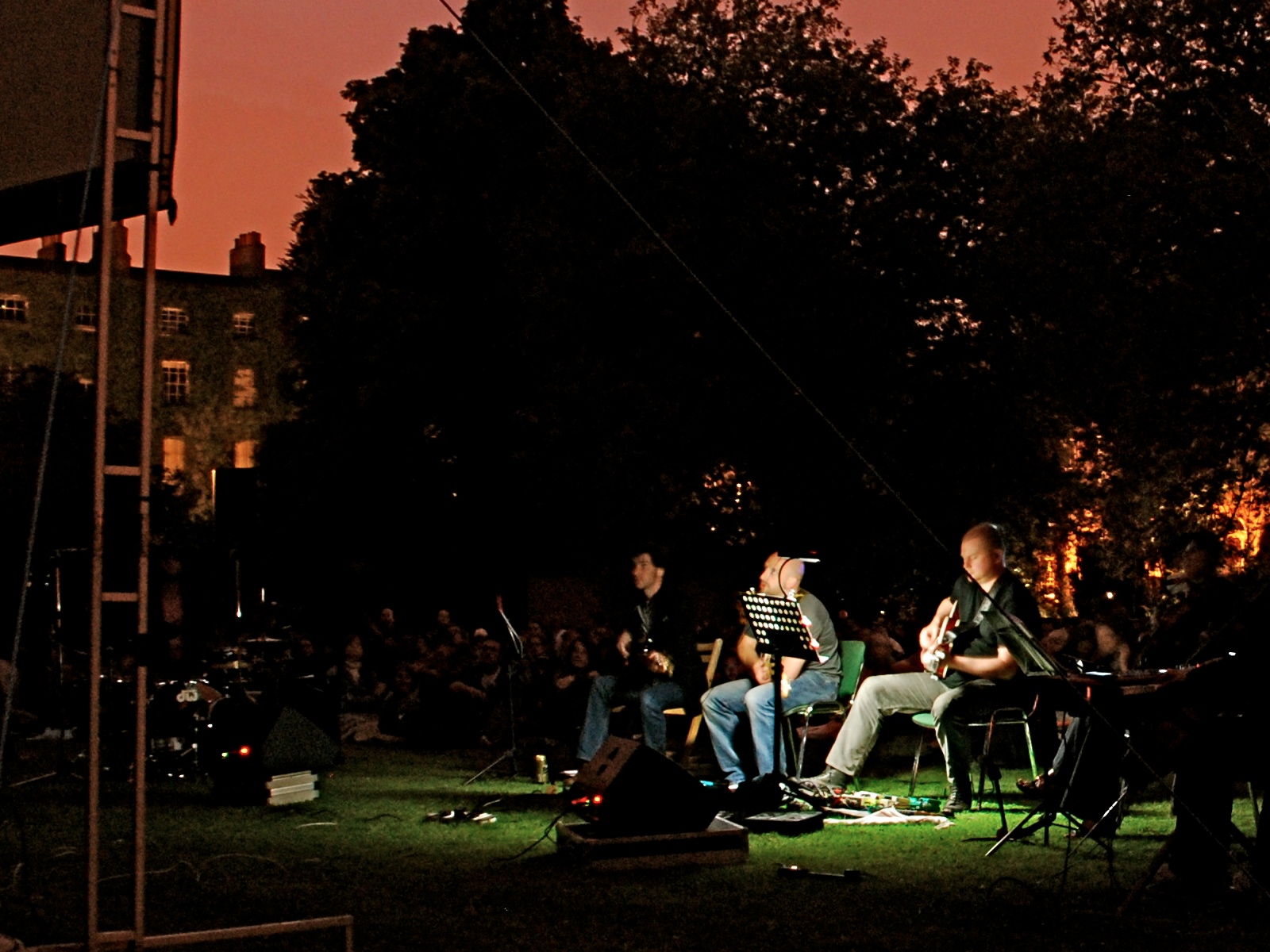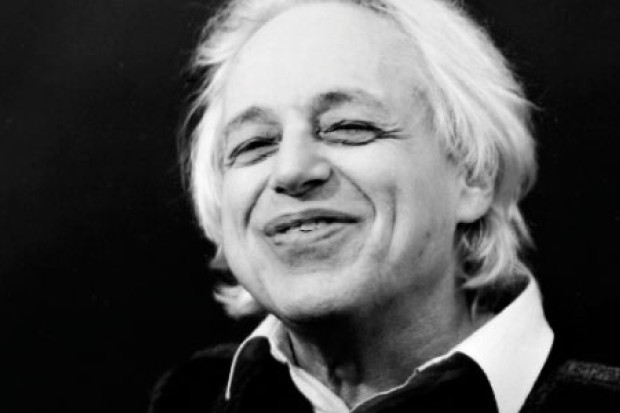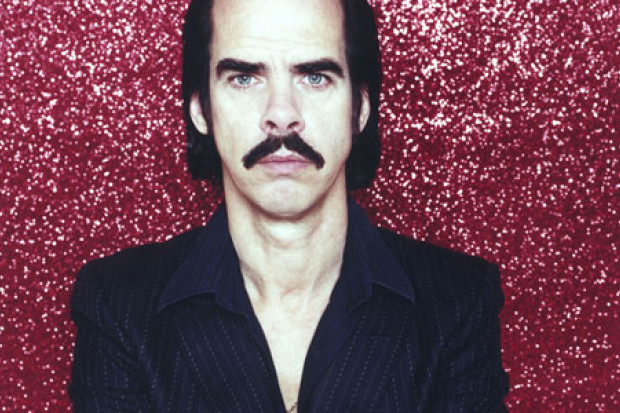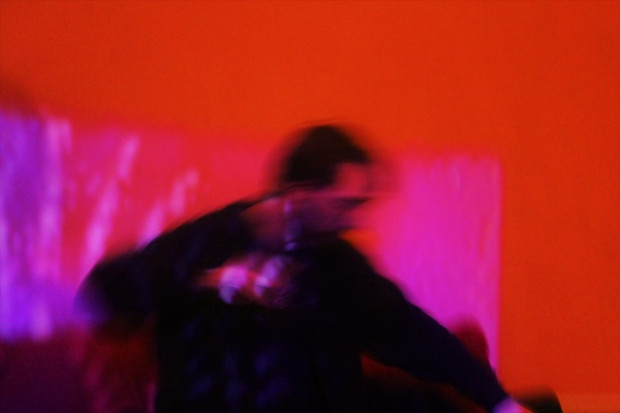
Before the Voice
3epkano playing live music to Faust in Dublin’s Fitzwilliam Square. Photograph: Janice Gaffey.
For Matthew Nolan, founder and driving force of the Dublin band 3epkano, film is more than just a day job (he lectures in film and media). It’s a passion, an obsession, and even ‘a backdrop to musical life’. It has certainly helped inform Nolan’s creative decisions. 3epkano’s choice to avoid the usual gigging band circuit is one of those decisions, motivated by an overriding passion for film and a desire to explore the grey areas where film and music meet. Even the band’s name is derived from the Russian title of Andrei Tarkovsky’s The Mirror: a film whose stream of consciousness is a perfect on-screen analogue to the organic flow of 3epkano’s music — strictly speaking 3epkano is pronounced ‘Zerkalo’ but few observe the Russian characters. Musically, the band occupy a strange, shifting territory, as if conducting experimental forays from a post-rock base camp, with melodic minimalism a constant companion. Their music, a balance of dense guitar and keyboard textures and delicate string playing is composed intuitively rather than by some thought-out logic. Its sound is all ambience and a subtle lyricism.
3epkano are purveyors of an infrequent art: live accompaniment to silent films. While once-upon-a-time all movies were performed with in-theatre musical accompaniment, attitudes have become increasingly purist towards these early films, and even Nolan admits that ‘I knew to a point I was doing a violence [to the films]’. Nolan’s intention was to give these films ‘another life’ and to invite a new experience of them. ‘It’s interesting that people associate the absence of the voice [in film] with something that’s under-developed,’ says Nolan, ‘but I would like to think that people are re-engaging with a tradition in film that is neglected. 3epkano focus almost exclusively on silent films from the early twentieth century, particularly the experimental films of the German Expressionists, such as Robert Wiene, feeling that they give the greatest scope for interpretation and experimentation. ‘Film, as a means of visual expression, wasn’t finished experimenting, and so much was sacrificed for focussing on the voice,’ Nolan explains. The experimental nature of these early silent films had an immediate appeal for Nolan, and was one of the inspirations for starting the band: ‘The things that get me excited about certain types of music, or visual art, or filmmaking, are occasions where a space is created for me to join in. The editing style [the directors from the silent era] adopted to tell stories with images had a wonderful musicality of its own. I think that’s what I found inspiring, and that’s what guides our decisions: trying to discern that internal musicality.’
Hans the Reluctant Wolf Juggler, released last month, is the third album from 3epkano. Despite the absence of visuals, which are so fundamental to their aesthetic and their live performances, this album reveals a carefully considered approach to music-making that marries the drive of improvised rock with a compositional precision more rooted in classical music. Each track on the album is highly evocative, with the creative space and internal musicality of film finding its match here in the ebb and flow of musical atmospheres. The band’s sensitivity with texture and timbre is all over the opening track, ‘Cat Strings’, in which layers of undulating strings build over a warm, almost drone-like base. The slow build-up into waves of distortion in ‘Rim Shak’ reveals the group’s darker side and deft handling of melodic layers. In contrast, ‘Riverbank’ is a moment of space and light, a sweet combination of sparse piano and guitar parts, overlaid once again with a rich string sound.
Film and music have an almost unique connection within the arts, as both are fundamentally temporal in nature: they exist only across time, and time is an intrinsic part of their composition. However, there is, as Nolan asserts, ‘a massive gulf between playing music to accompany a screening and the things you need to attend to when writing a score’. A completed score, just like a completed film, is a fixed entity, but a musical accompaniment, especially one in which improvisation plays a key role, is not. Rather than ‘playing the dots’, each player is engaged in a continual creation and recreation of relationships, making each performance a unique and dynamic event, and making the performers catalysts of constant change. That so little of the music is determined beforehand means that each second of the performance is fraught with potential connections and divergences, juxtapositions and separations. The ever-evolving music is placed in direct contrast with the fixed work that is the film, with the relationship between the two in a constant state of flux. Improvisation transforms the film from a fixed entity into a new and unique event, a work that evolves and develops with each performance. 3epkano are, in Nolan’s words, ‘playing with associations… engaged with an ongoing dialogue or dialectic with the screen, hoping that something new will come out of the meeting’.
This summer, 3epkano returned to the first film they ever scored, Robert Wiene’s influential The Cabinet of Dr Caligari, for a collaboration with the composer and organist Eric Sweeney, also known for his accompaniment of silent films. The collaboration was more than just a meeting of disparate approaches, but of disparate musical traditions brought together by the desire to create dynamic musical events from films. Both 3epkano and Eric Sweeney go to great pains to avoid over-determining the music for a film, whether through over-planning or over-rehearsal, in order not to compromise this re-realisation of films as events. They prefer to let the film become the framework for this new audio-visual event, the basic structure from which music can grow organically. For 3epkano, this framework suggests a minimal harmonic structure and melodic sketches upon which the band build live, developing these basic ideas into a dense web. Each member of the band helps to building these simple motifs into a complex web, with a sensitivity to the resulting textures and tone that results in a rich ambient mix of classical technique and rock-based momentum. As a solo organist, Sweeney’s work belongs to a tradition far removed from that of the band: his improvisations with films are solo undertakings born of his experience as composer and classical performer. While 3epkano create a dense layers of simple motifs on strings, guitars and keyboards, Sweeney calls on the timbral potentials of the organ and his own virtuosic playing to create a more complex analogue to the on-screen action. For Sweeney, collective improvisation was a new experience, but a fascinating one, feeling as natural and human as a conversation. ‘In a conversation, you know what the subject is going to be, and you have some general ideas, but you never work out things exactly. We know what we’re going to talk about, but we haven’t got a script. You have to get rid of the comfort blanket of scores, and when you do it can be wonderful what comes out.’
While both 3epkano and Eric Sweeney have branched out in their performances (3epkano to work with filmmakers such as Donal Dineen, and Sweeney to work with architects and historians), it is to the same era of silent movies they return. It is not only for a love of the visual language these films inhabit, or the scope for experimentation they provide, but also for the sense of connection to a tradition long passed and an aesthetic long gone. Any 3epkano performance is extending a hand across generations, combining the music’s distinctly contemporary aesthetic with the film’s distinctly twentieth century expressionistic one. ‘At the meeting of art from one generation and some creative impulse from another, some special things can happen,’ says Nolan. For 3epkano and Eric Sweeney, it is the film that provides both the creative spark and the framework for the music.
Published on 5 December 2011
Anna Murray is a composer and writer. Her website is www.annamurraymusic.com.












